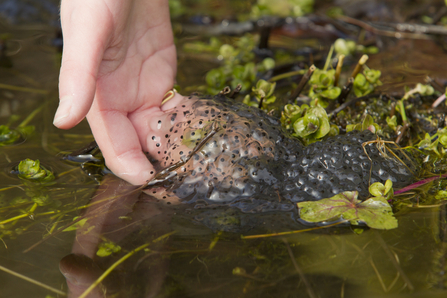
Girl's hand holding spawn of Common frog (Rana temporaria) in garden pond in spring. Picture: Mark Hamblin/2020Vision
Hares boxing in a field. Picture: Russell Savory

Girl's hand holding spawn of Common frog (Rana temporaria) in garden pond in spring. Picture: Mark Hamblin/2020Vision
Garden ponds across the UK provide an estimated 2 million breeding sites for frogs and toads. Each spring spawn starts appearing in the warmest south west then sightings spread north east. We have already seen several clutches of gelatinous eggs popping up in garden ponds this year. Did you know - when frogs mate, males release sperm into the water at the same time the females release their eggs, with the fertilisation happening in the water.
Build a garden pond (https://youtu.be/NPwEvxYhfSg)
Create a wildlife pond

Ground-nesting birds: skylark (Roy McDonald), nightjar (David Tipling) and Dartford warbler (Ben Hall).
The first of March marks the official start of the UK's ground-nesting bird season: from now until the end of July, migratory species will return to breed in the UK, for example nightjars come from Africa and start making their nests on heathlands like our Greenham and Snelsmore Common reserves. Because they nest on the ground, these birds are extremely vulnerable to disturbance so we ask visitors at those reserves to stick to the paths and keep their dogs on the paths, too, except in designated areas.
Read more about our rules for visitors during ground-nesting bird season
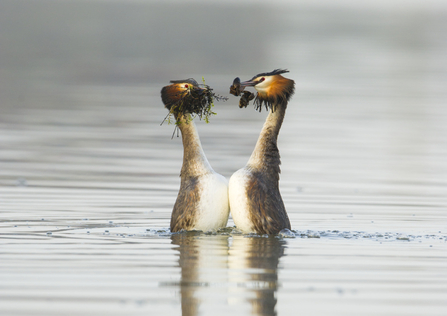
Great crested grebe weed dance © Andrew Parkinson/2020VISION
The mating display of great crested grebes is famous the world over: breeding pairs perform extraordinary tango-like dances on the water, decorating their heads with pond weed which they shake seductively to entice their partner. You can spot grebes on the lake at our Nature Discovery Centre in Thatcham, and Weston Turville or Foxcote Reservoirs, both in Bucks.

An urban fox scavenging for food in a bin. Picture: Terry Whittaker/2020Vision
March is the time of year when vixens first start to give birth. The vulnerable cubs won't emerge from their dens for four or five weeks, and in the meantime males are responsible for feeding the family. That makes March a good time of year to spot males out and about, especially in the daytime, hunting rabbits and other small mammals and taking them back to the cubs.
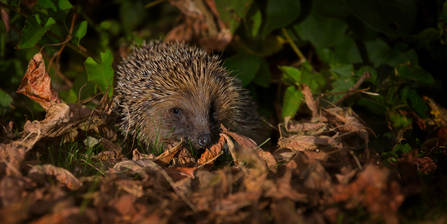
Hedgehog © Jon Hawkins - Surrey Hills Photography
March is also the month when hedgehogs usually emerge from hibernation and go hunting for their first proper meal in months. A nutritious earthworm or juicy slug is ideal, but in the modern world even that can be a challenge. If you want to help a hedgehog, put out a bowl of kitten biscuits or meat-based wet dog or cat food. You can also use specialist hedgehog food but keep in mind that this isn't regulated and can vary in quality so always make sure to check.
Bee-fly by Sue Taylor
Bee-flies are a group of true flies (like bluebottles and house flies) that have evolved yellow and orange fur which mimics bumblebees. In March they are among the first flying insects to appear on sunny days, hovering in front of primroses and drinking nectar like tiny hummingbirds. Listen out for the high-pitched whine produced by flapping their wings hundreds of times a second. Every spring there is a light-hearted competition to see who will be the first to see a bee-fly, part of the ‘Bee-fly Watch’ national monitoring scheme.
Find out more about bee-flies in this blog by our volunteer recorder Sue Taylor
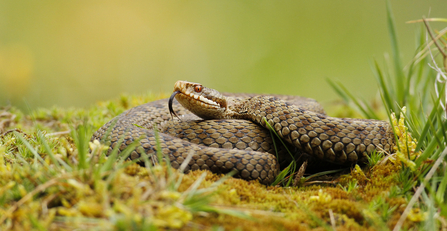
Adder basking on the mossy ground by Jon Hawkins
Adders spend the winter curled up in hiding holes which ecologists call hibernacula, several snakes often squeezing together to share warmth. Reptiles used to be called 'cold-blooded', but we now call them poikilothermic, meaning their body temperature varies with the air around them. Look out for adders emerging on the first warm days at heathlands, like our Wildmoor Heath reserve in Berkshire.

Bob Coyle
March marks the start of blackbird breeding season: if you are quiet and patient you might be lucky enough to see a male performing his courtship dance including head-bowing, an open beak and a 'strangled' low-pitched song. You can also listen out for blackbirds singing their spring song which is described as being 'treaclier' than their winter tune, and a sure sign that spring has arrived.
Listen to a blackbird singing:
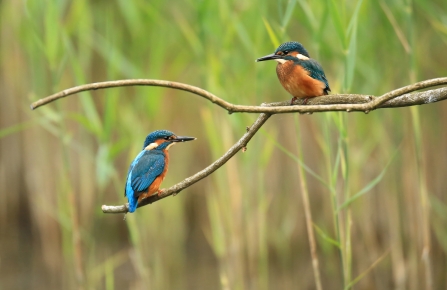
Kingfishers by Jon Hawkins - Surrey Hills Photography
With their bright amber and azure plumage, kingfishers are famous as one of the most colourful and attractive UK birds - but did you know they lay their eggs underground? Each spring they burrow into sandy riverbanks - but they also defend their territory by performing elaborate mid-air motions to scare rivals away. Our Chimney Meadows reserve on the banks of the Thames in West Oxfordshire is just one good place to see these dazzling birds in action.
Hares 'boxing' in a field. Picture: Russell Savory
One of the most famous signs of spring in the British Isles is 'boxing' hares, and we have already seen displays starting at our Wells Farm nature reserve in South Oxfordshire. Contrary to popular belief, 'mad March hares' is not about male posturing or machismo, but is usually a female or 'jill' fending off the attentions of a jack, either to show that she is not yet ready, or as a test of his determination!
Sign up below to receive the latest news from BBOWT, tips about how you can help wildlife, plus information on how you can get involved.